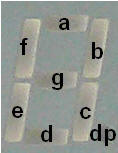| |
The four seven segment (+ decimal point) at the
NEXYS/ BASYS kit must be used in a multiplexed manner where only one
display light up during the cycle. (Read more in the NEXYS/ BASYS
documentation)
The first step in order to create
a multiplexed display driver will be the Bcd to 7-segment driver
(actually a Hex to 7-segment driver)
|
 |
No1_Bcd27segm_Bitfiles.zip (Bit-files to
download for testing at the kit / but its your design which
should be downloaded)
 |
(BASYS
/NEXYS) Bcd27segm_boardtest1.bit
a simple driver for one display |
 |
(BASYS / NEXYS)
Bcd27segm_boardtest2.bit a simple driver for two
displays |
 |
Also included -
UCF-files for both designs |
|
|
Problem: BCD to 7 segment
|
1a) Fill out the Truth table below
1b)
Choose a strategy for
the solution like:
>> Implement the min. term. equations
for each segment
>> Reduce the Boolean with Carnaugh
charts
>> Consider using a 1 out 16 Decoder
+ some logic
>> VHDL could be a solution ... but
maybe its a bit early for this
1c) Implement the solution
and test it on the board. - Bcd27segm_boardtest1.bit will
demonstrate how the problem should be solved
|
| |
 |
| |
Segments |
|
Bcd(3:0) |
a |
b |
c |
d |
e |
f |
g |
| 0000 |
0 |
0 |
0 |
0 |
0 |
0 |
1 |
| 0001 |
1 |
0 |
0 |
1 |
1 |
1 |
1 |
| 0010 |
0 |
0 |
1 |
0 |
0 |
1 |
0 |
| 0011 |
0 |
0 |
0 |
0 |
1 |
1 |
0 |
| 0100 |
1 |
0 |
0 |
1 |
1 |
0 |
0 |
| 0101 |
0 |
1 |
0 |
0 |
1 |
0 |
0 |
| 0110 |
0 |
1 |
0 |
0 |
0 |
0 |
0 |
| 0111 |
0 |
0 |
0 |
1 |
1 |
1 |
1 |
| 1000 |
0 |
0 |
0 |
0 |
0 |
0 |
0 |
| 1001 |
0 |
0 |
0 |
0 |
1 |
0 |
0 |
| 1010 |
0 |
0 |
0 |
1 |
0 |
0 |
0 |
| 1011 |
1 |
1 |
0 |
0 |
0 |
0 |
0 |
| 1100 |
0 |
1 |
1 |
0 |
0 |
0 |
1 |
| 1101 |
1 |
0 |
0 |
0 |
0 |
1 |
0 |
| 1110 |
0 |
1 |
1 |
0 |
0 |
0 |
0 |
| 1111 |
0 |
1 |
1 |
1 |
0 |
0 |
0 |
|
| |
Truth table for the bcd27segm version 1 |
 |

|
| |
 |
Alternative
schematic and Bcd27segm decoder
|
|
|
Next step: Download this bit-file
Bcd27segm_boardtest2.bit to your computer and then try the following..
Set
switch <7:0>
like this "0001 0010" or what you like to try, press and release
Btn0 in quick sequences.
1d)
Create a new version of your design, which
implements the same multiplexed functionality.
|
|
|
